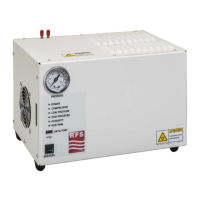
Do you have a question about the RFS APD-D Series and is the answer not in the manual?
| Brand | RFS |
|---|---|
| Model | APD-D Series |
| Category | Industrial Electrical |
| Language | English |
Covers critical warnings and cautions regarding hazardous voltage and automatic equipment startup.
Procedure for purging the site's distribution system before dehydrator installation.
Ensuring no flow restrictions in the dry air distribution system for optimal operation.
Guidelines for selecting an appropriate installation location and required clearances.
Step-by-step guide for installing the dehydrator and connecting it to the system.
Common issues encountered during installation and their possible solutions.
Defines Relative Humidity (RH) as moisture content relative to air temp.
Defines Dew Point Temperature (Td) as the saturation point of air at a given temp.
Defines Dew Point Reduction (Tdr) as efficiency measure for dehumidification.
Defines the distribution system components pressurized by dry air.
Describes when the dehydrator's compressor is on and supplying pressurized air.
Defines Run Time as the duration of active operation to pressurize the system.
Describes when the unit is energized but the compressor is off, monitoring pressure.
Defines Duty Cycle as the ratio of active to standby operation time.
The configured pressure at which the dehydrator switches to active operation.
The configured pressure at which the dehydrator switches to standby operation.
Explains the importance of dew point temp and the dehydrator's function.
Shows the acceptable ambient environment conditions for operation.
Explains the automatic operation, pressure monitoring, and duty cycle limits.
Guidance on model selection and overview of optional features like alarms and purge.
Details specific optional alarms for High Pressure, Humidity, and Run Time.
Description of the 0-15 psig pressure gauge on the front panel.
Explanation of the LED indicators for Power, Compressor, Pressure, Humidity, and Run Time.
Details the USB Data Port for logging, configuration, and software updates.
Covers circuit breaker reset and rear panel AC input/output fittings.
Details the case fan for cooling and alarm port/connector for remote monitoring.
Overview of preventative maintenance: checking input air filter and cleaning.
Steps for safely taking the unit out of service and removing the lid for access.
Procedure for inspecting and replacing the compressor's input air filter element.
Procedure for replacing the Real-Time Clock (RTC) backup battery.
Steps for reconnecting the lid and returning the unit to its operational location.
Steps for upgrading options, configuration, and software via USB.
Details on process indicators, log files, and verification steps for successful upgrades.
Key parameters including output flow, volume, pressure, and temperature ranges.
Details on voltage, current, power consumption, and wiring configuration.
Information on alarm configurations, unit dimensions, and weight.
Environmental operating limits and configurable options like pressure and humidity alarms.
Explanation of the RFS digital dehydrator model naming convention.
Details on dehydrator series and configuration of upper/lower operational pressures.
Configuration options for humidity, run time, high pressure alarms, and system purge.
Formula and variables for estimating dehydrator run time based on system volume.
Practical examples of Excel formulas for calculating run time and associated parameters.
Table of volume estimates for various RFS elliptical waveguide types.
Table of volume estimates for Commscope/Andrew elliptical waveguide types.
Table of volume estimates for EIA rectangular waveguide types.
Table of volume estimates for rigid coaxial transmission line types.
Declaration of product conformity to relevant EU directives and standards.